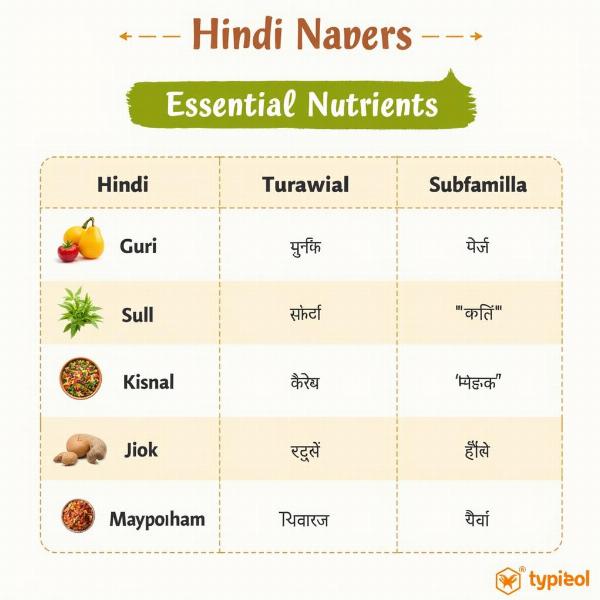Understanding nutrition is crucial for a healthy life, and knowing how to discuss it in Hindi can be incredibly beneficial, especially in India. “What is the meaning of nutrition in Hindi?” is a common question, and the answer is multifaceted. While the most straightforward translation is “poshan” (पोषण), the concept encompasses much more than just food. It involves understanding the processes by which our bodies absorb and utilize nutrients for growth, repair, and overall well-being.
Understanding “Poshan” (पोषण): More Than Just Food
“Poshan” (पोषण) is the most common Hindi word for nutrition. However, it’s essential to recognize that nutrition in the Indian context goes beyond mere sustenance. It’s intertwined with cultural practices, traditional beliefs, and the availability of diverse food resources. It considers not just what we eat, but also how we eat, and the impact of our food choices on our physical and mental health. This holistic approach is deeply rooted in ancient Indian texts like the Ayurveda, which emphasizes the balance of doshas and the importance of consuming foods appropriate for one’s individual constitution.
The Six Essential Nutrients and Their Hindi Equivalents
Just like in English, Hindi recognizes the six essential nutrients: carbohydrates, proteins, fats, vitamins, minerals, and water. Knowing their Hindi names can help you navigate conversations about healthy eating in India. For example, carbohydrates are known as “karbohydrate” (कार्बोहाइड्रेट), proteins as “protein” (प्रोटीन), and fats as “vasa” (वसा). Vitamins are “vitamin” (विटामिन), minerals are “khanij” (खनिज), and water, of course, is “jal” (जल).
Why Knowing These Terms Matters
Understanding the Hindi terminology for nutrients can empower you to make informed food choices when shopping, cooking, or dining in India. It allows you to connect with local communities and learn from their traditional dietary wisdom. Imagine discussing the benefits of “protein” (प्रोटीन) for muscle growth with a local shopkeeper or understanding the importance of “khanij” (खनिज) from a traditional healer. This linguistic bridge fosters a deeper understanding of Indian culture and its approach to nutrition.
 Chart of nutrients in Hindi
Chart of nutrients in Hindi
Nutrition Beyond the Basics: A Cultural Perspective
In India, nutrition is deeply intertwined with social and religious customs. Festivals often revolve around specific foods, and dietary restrictions are common based on religious beliefs or individual preferences. Understanding these cultural nuances is essential for grasping the true meaning of nutrition in the Indian context. For instance, during Navratri, many Hindus observe a fast and consume specific “satvik” foods. This practice, while rooted in tradition, also has nutritional implications.
Navigating Dietary Restrictions and Preferences
India’s diverse population embraces a wide range of dietary practices, from vegetarianism and veganism to specific restrictions based on allergies or religious beliefs. Communicating these preferences effectively requires knowledge of relevant Hindi vocabulary. Knowing how to express that you’re a “shakahari” (शाकाहारी – vegetarian) or have an allergy to “doodh” (दूध – milk) can be vital for ensuring your nutritional needs are met.
How to Improve Your Nutrition: Practical Tips in Hindi
While understanding the meaning of nutrition is crucial, putting that knowledge into practice is even more important. Here are some practical tips, incorporating Hindi terminology, to enhance your nutritional intake:
- Increase your intake of “phal” (फल – fruits) and “sabziyan” (सब्जियां – vegetables): Aim for a variety of colorful produce to ensure a wide range of vitamins and minerals.
- Choose whole grains over refined “anaaj” (अनाज – grains): Opt for “atta” (आटा – whole wheat flour) over “maida” (मैदा – refined flour) for rotis and other bread products.
- Include “daal” (दाल – lentils) and other “legumes” (फलियां) in your diet: These are excellent sources of protein and fiber.
- Drink plenty of “jal” (जल – water): Staying hydrated is crucial for all bodily functions.
Conclusion: Embracing a Holistic Approach to “Poshan”
Understanding “what is the meaning of nutrition in Hindi” involves recognizing the cultural significance of “poshan” (पोषण) and its broader implications for health and well-being. By embracing a holistic approach, incorporating traditional wisdom with modern nutritional science, and learning the relevant Hindi vocabulary, you can empower yourself to make informed food choices and lead a healthier, more fulfilling life.
FAQ
- What is the simple meaning of nutrition in Hindi? The simplest translation of nutrition in Hindi is “poshan” (पोषण).
- What are the six essential nutrients called in Hindi? They are “karbohydrate” (कार्बोहाइड्रेट), “protein” (प्रोटीन), “vasa” (वसा), “vitamin” (विटामिन), “khanij” (खनिज), and “jal” (जल).
- Why is understanding Hindi nutrition terms important? It helps navigate food choices and conversations about health in India.
- What is a “Poshan Thali”? It’s a balanced Indian meal plate with diverse food groups.
- How does culture influence nutrition in India? Festivals, religious beliefs, and regional preferences play a significant role.
Meaning-Hindi.in is your premier destination for professional Hindi translation services. We specialize in various areas, including business, legal, technical, website localization, and educational document translation. Our team of expert linguists ensures accurate and culturally sensitive translations to bridge the communication gap. Need help with your translation needs? Contact us today at [email protected] or call us at +91 11-4502-7584. Meaning-Hindi.in offers quick and reliable translation services tailored to your specific requirements.